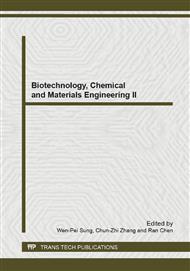[1]
Chang V, Holtzapple, M. Fundamental factors affecting biomass enzymatic reactivity. Appl Biochem Biotechnol. Vol. 84–86 (2000), p.5–37.
DOI: 10.1385/abab:84-86:1-9:5
Google Scholar
[2]
Joseph A. Rollin, Zhiguang Zhu, Noppadon Sathitsuksanoh. Increasing Cellulose Accessibility Is More Important Than Removing Lignin: A Comparison of Cellulose Solvent-Based Lignocellulose Fractionation and Soaking in Aqueous Ammonia. Biotechnology and Bioengineering. Vol. 108 (2011).
DOI: 10.1002/bit.22919
Google Scholar
[3]
Maryvonne W, Daniele L. Microwave pretreatment of sections to improve the immunocytochemical detection of progesterone receptors in the guinea pig hypothalamus. Journal of Neuroscience Methods. Vol. 104 (2000), p.27–34.
DOI: 10.1016/s0165-0270(00)00320-4
Google Scholar
[4]
Liang G., Xiao Ming L, Xie B. Impacts of sterilization, microwave and ultrasonication pretreatment on hydrogen producing using waste sludge. Bioresource Technology. Vol. 99 (2008), pp.3651-3658.
DOI: 10.1016/j.biortech.2007.07.026
Google Scholar
[5]
Azuma J, Tanaka F, Koshijima T. Enhancement of enzymatic susceptibility of lignocellulosic wastes by microwave irradiation. Ferm Technol. Vol. 62 (1984), p.77–84.
Google Scholar
[6]
Kitchaiya P, Intanakul P, Krairish M. Ehancement of enzymatic hydrolysis of lignocellulosic wastes by microwave pretreatment under atmospheric pressure. Wood Chem Technology. Vol. 23 (2003), p.217–225.
DOI: 10.1081/wct-120021926
Google Scholar
[7]
Muthukumar M, Mohan D, Rajendran M. Optimization of mix proportions of mineral aggregates using Box Behnken design of experiments. Cem Concr Compos. Vol. 25 (2003), p.751–758.
DOI: 10.1016/s0958-9465(02)00116-6
Google Scholar


